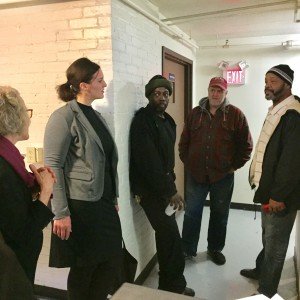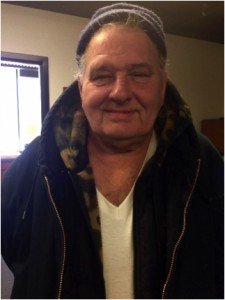By TESHA M. CHRISTENSEN
“Would you want your parents or grandparents homeless?” asked Alliance Housing Inc. (AHI) Executive Director Barbara Jeanetta. “It is nearly impossible for anyone to accomplish much positive in their lives without stable housing.”
To help ease the problem of homelessness in those over 55, AHI is constructing a four-story apartment building with 41 studios to house homeless single adults age 55 and over. Frey Flats will be built on the vacant lot at 3001 E. Lake St.
 Photo right: (From left), Alliance Housing Inc. Executive Director Barbara Jeanetta and Human Services Commissioner Emily Piper talk with Alliance Housing rooming house residents Richard Love, Michael Huffman and Tracy Muse on Tues., Nov. 15, in Minneapolis. Piper announced this year’s Live Well at Home grants while visiting an Alliance Housing Incorporated building in Minneapolis’s Whittier neighborhood that serves primarily older Minnesotans with low incomes. Alliance Housing is receiving $700,000 to help build a new 41-unit affordable housing project in the Longfellow neighborhood to serve older homeless adults, a population that is on the rise across Minnesota. In 2015, the number of homeless adults age 55 and older was 843, an 8 percent increase from 2012, according to Wilder Research’s most recent one-night statewide study of homeless people. (Photo submitted)
Photo right: (From left), Alliance Housing Inc. Executive Director Barbara Jeanetta and Human Services Commissioner Emily Piper talk with Alliance Housing rooming house residents Richard Love, Michael Huffman and Tracy Muse on Tues., Nov. 15, in Minneapolis. Piper announced this year’s Live Well at Home grants while visiting an Alliance Housing Incorporated building in Minneapolis’s Whittier neighborhood that serves primarily older Minnesotans with low incomes. Alliance Housing is receiving $700,000 to help build a new 41-unit affordable housing project in the Longfellow neighborhood to serve older homeless adults, a population that is on the rise across Minnesota. In 2015, the number of homeless adults age 55 and older was 843, an 8 percent increase from 2012, according to Wilder Research’s most recent one-night statewide study of homeless people. (Photo submitted)
Homelessness in adults over 55 is the only growing area of the homeless population in Hennepin County. The problem is expected to get worse as the number of Baby Boomers over 55 grows in the next decade.
Statewide, the 2012 single night Wilder Survey counted 777 men and women aged 55 and older, which is a 47% increase in their numbers over the 2009 Wilder Survey. In 2015, the number of homeless adults age 55 and older was 843, an 8 percent increase from 2012.
What people don’t understand
Jeanetta has found that most people don’t understand the level of chronic homelessness among adults over 55.
“Many of these adults have never had a place of their own or certainly not for many years,” said Jeanetta. “There is a high level of alcoholism and mental illness. Housing has proven to mitigate the problems from both.”
AHI plans to have a capable, experienced service provider on staff through Touchstone Mental Health that can address the health, well-being and behavior of tenants.
There are good examples of how stable housing and a supportive community environment are a foundation for a more positive lifestyle and opportunity to make other positive change. The lack of it leads to other chaos.
A 2012 report sponsored by the Family Housing Fund, “Financial Implications of Public Interventions on Behalf of a Chronically Homeless Family” documented significant savings of public dollars in emergency medical care, foster care, substance abuse treatment, and incarceration when people have stable and supportive housing.
Also, these elder adults are easy victims of assault, theft and other crime that further sets back opportunities for stability.
A shelter bed at Hennepin County cost $30 a day. A hospital stay at Hennepin County Medical Center for alcohol/drug use treatment is a minimum of $4,169 a day. A night is jail is $378 per day.
A room at an Alliance Housing facility costs $9-15 a day.
More than a bed
Optimistically, AHI will begin construction on Frey Flats in 2018.
“To keep rents affordable to very low-income persons, we raise money from public sources that don’t have to be repaid (city, county, state),” explained Jeanetta.
Currently, AHI has raised $1.2 million from the Department of Health Services and the city of Minneapolis. AHI has a $500,000 request pending with the Federal Home Loan Bank and will ask the State Housing Agency for about $8 million in the summer of 2017. AHI also needs housing infrastructure bonds that will need to be authorized by the State Legislature in the 2017 session.
While the design has not been finalized, it will include community, office and service space with a traditional storefront look.
The building will have elevators, a sizable community room, an office for rental and tenant services, a laundry, and storage areas. The efficiency units will all be furnished.
Outside there will be an area for grilling and a small area to raise vegetables and flowers.
AHI intends to operate the building with a live-in caretaker and a secure front desk. Very often, persons moving out of homelessness lose their housing because they cannot keep their old friends and associates out of their new place, explained Jeanetta. Having eyes on the property or a secure front desk help residents maintain their housing stability and ease the pressure of unwanted guests. AHI’s rooming house at 2011 Pillsbury has a live-in caretaker that compliments its property manager and has an excellent reputation with neighbors and the Minneapolis police.
AHI is seeking a service partner to assist residents with maintaining housing stability, managing health and well-being, and accessing community services. Conversations are underway with St. Stephens Human Services, Catholic Charities, Jewish Children and Family Services, and Longfellow Seward Healthy Seniors.
Alliance’s caretaker and the building design and amenities will support a connected community of residents. Often it is difficult for homeless individuals to transition away from and replace their “community of the streets.” Community space for passive and organized activities will help residents recognize and support their neighbors.
AHI creates long-term solutions
AHI was born out of the vision of St. Stephens’ Catholic Church volunteers and emergency shelter staff and residents who wanted to create tangible, long-term housing solutions for homeless families and individuals.
The nonprofit (not religious affiliated) organization was incorporated in 1991 and took advantage of vacant and available properties at low cost in South Minneapolis. Alliance continues to honor its history by developing housing solutions for homeless, poor and other individuals shut out of market opportunities.
Alliance’s programs and activities include affordable housing development and management and supportive housing programming for families. Its 450 units of housing serve a continuum of single adults to families.
Hiawatha Commons (2740 Minnehaha Ave.) in Longfellow is four-story, brick apartment building located a short walk from the Hiawatha Light Rail station on Lake St. This transit-oriented, mixed-income project was designed for low-wage workers who work in the neighborhood or at the airport, Mall of America and Downtown. The building was opened in 2006 and its 80 units stay leased consistently.
Meet Tom McDaniels
AHI’s housing development and property management fills a critical niche in Minneapolis’ affordable housing marketplace. Units fall among the most affordable in the city at 15-35% below market rents.
 Alliance rents to tenants that other landlords turn down because of their low income or poor rental and criminal histories, like 75-year-old Tom McDaniels (photo left submitted). He had spent three years living in his car, after five years of camping out in the Minnesota cold, because a 30-year-old felony staining his record made finding affordable housing nearly impossible. Having spent many years in prison, McDaniels only has seven years of work experience, which provide him with just enough in social security and other benefits to make ends meet. On top of rent, McDaniels has regular medical expenses that come along with the health conditions he is faced with as he ages.
Alliance rents to tenants that other landlords turn down because of their low income or poor rental and criminal histories, like 75-year-old Tom McDaniels (photo left submitted). He had spent three years living in his car, after five years of camping out in the Minnesota cold, because a 30-year-old felony staining his record made finding affordable housing nearly impossible. Having spent many years in prison, McDaniels only has seven years of work experience, which provide him with just enough in social security and other benefits to make ends meet. On top of rent, McDaniels has regular medical expenses that come along with the health conditions he is faced with as he ages.
In January 2015, McDaniels moved into an AHI rooming house at 2011 Pillsbury Ave. He no longer has to worry about where he’s sleeping that night.
Alliance’s work makes it possible for individuals and families to create homes for themselves, regardless of income and background by developing and managing housing that is inclusive, affordable, relational, and flexible, according to Jeanetta.
Site on good transit corridor
AHI discussed the Frey Flats concept with Longfellow’s Community Development and Environment Committee in January 2016. Residents who attended the meeting were generally supportive and had questions related to design and use of green features.
AHI had hoped to construct this 55 plus building in the Phillips neighborhood, but wasn’t able to secure funding.
“We were searching for a site along a good transit corridor,” explained Jeanetta. “This site was available and within a reasonable price range. Longfellow has been very welcoming all along the process.”
Comments
No comments on this item Please log in to comment by clicking here